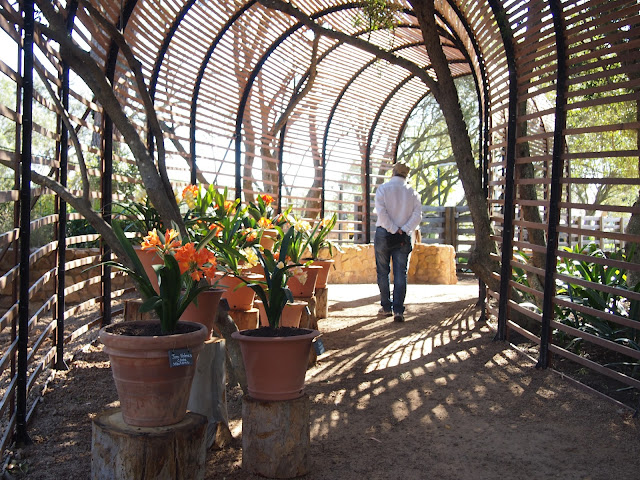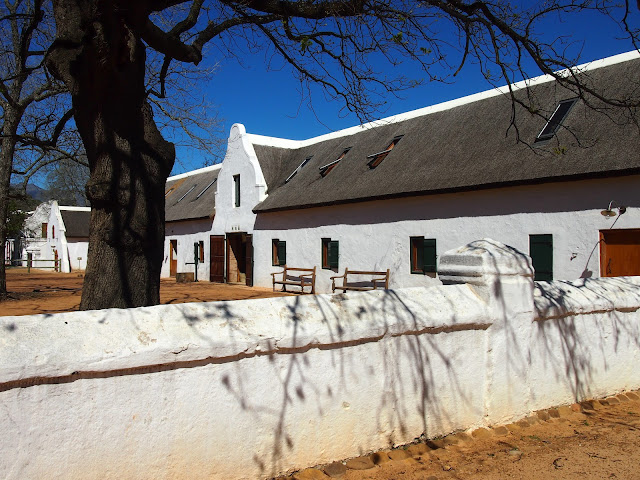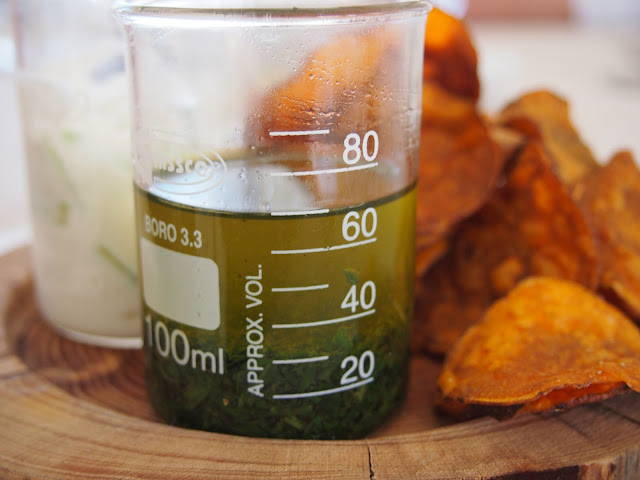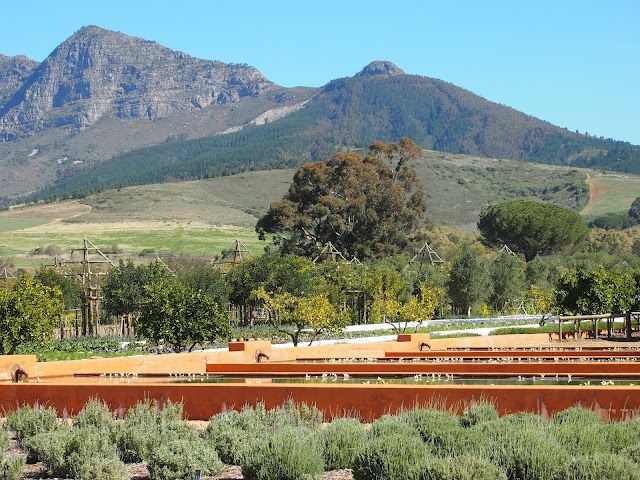THE ABUNDANT EXPERIENCE THAT IS 'BABYLONSTOREN'
Recently, I wrote about an unusual and beautiful garden in the Loire Valley quite near to Boussac - Prieure d' Orsan. If you haven't read it , have a look here.
Patrice Taravella, one of the architects responsible for restoring the Priory Gardens in France, was also commissioned to assist with the design of a relatively new garden on the Babylonstoren Wine Estate near Franshoek, South Africa. Having visited both gardens recently, it was interesting to note the similarities and contrasts between them.
The climate in Franshoek is very different to that of the Loire Valley. The soil conditions, the light, as well as the plant choices are also very different in both gardens. The plants and trees at Babylonstoren needed to be much more robust to cope with the heat and sometimes very dry conditions of the Western Cape summer. Some of the wooden structures are similar to those in France, and I would love to fast forward to a visit to Babylonstoren in five years time!
This newer garden of Babylonstoren is at the heart of the Estate, and covers eight acres. It is laid out in a grid and there are three axis points. The timber structures and tree plantings are formal and over 300 varieties of plants using bio-dynamic systems, are edible. There are 15 divisions including vegetables, berries, indigenous plants as well as a 'Prickly Pear Maze'. The watering of the garden is achieved using age old gravity methods. The various walks through the garden total over 3 kilometres.
The vegetable and fruit gardens supply the Babel Restaurant as well as the Farm Hotel on Babylonstoren. These formal beds, some bordered by espaliered fruit trees, are divided by walk-ways, some of which are covered with peach pips instead of gravel.
We had lunch at Babel before our stroll around the gardens and the food was superb. Below an assortment of photographs of the abundant experience that is Babylonstoren.

 |
| Fruit trees trained onto a timber trellis |
 |
| Fig trees are trained over slanting timber structures, facing the sun. This, together with the wall behind, providing protection and increasing the heat, will ensure abundant fruit. |
 |
| Timber structures against the backdrop of the mountains |
The owners are currently expanding the Clivia garden. There are over 7000 Clivias (indigenous to South Africa) growing alongside the stream, beneath wild Olives and Oak trees. A new timber structure, known as The Puff Adder has been built to display the new Clivia collection. 'The structure of balau slats on steel frames, designed by Patrice Taravella and engineered by Terry de Waal, eliminates about 40% of sunlight but allows a free flow of air, creating ideal conditions in which Clivias can thrive'. Unfortunately, we were just a little too early to see the Clivias in full bloom, although those in the timber tunnel were abundant.
 |
| Clivias beneath the wild olives alongside the old stone wall |
 |
| The more unusual yellow Clivia |
 |
| This lovely stream which runs beside the Clivia walk. |
 |
| The Clivia walk - the stream on the right and the fruit orchards on the left. |
Babylonstoren is a 240 hectare working wine and fruit farm that dates back over 300 years.
The buildings are all very well preserved and some of the original structures, date back to 1690. There is a main residence which dates back to 1770, an old cellar, a "Koornhuis" where wheat and hay was stored, a row of service buildings or barns, a bell tower, an ornate chicken run and dovecote. All of these buildings are surrounded by old traditional low farm walls. Some of the buildings have been converted into guest suites with Cape Dutch gables and thatched roofs. The Hotel offers a Spa and delightful accommodation with magnificent views of the farm and the majestic mountains that surround the farm on three sides.
 |
| Babel - the restaurant |
 |
| The unusual olive oil and vinegar containers |
I hope you have enjoyed the assortment of photographs of the abundant experience that is Babylonstoren.


























महाकालसंहिता कामकलाकाली खण्ड पटल १५ - ameya jaywant narvekar कामकलाकाल्याः प्राणायुताक्षरी मन्त्रः
ReplyDeleteओं ऐं ह्रीं श्रीं ह्रीं क्लीं हूं छूीं स्त्रीं फ्रें क्रों क्षौं आं स्फों स्वाहा कामकलाकालि, ह्रीं क्रीं ह्रीं ह्रीं ह्रीं हूं हूं ह्रीं ह्रीं ह्रीं क्रीं क्रीं क्रीं ठः ठः दक्षिणकालिके, ऐं क्रीं ह्रीं हूं स्त्री फ्रे स्त्रीं ख भद्रकालि हूं हूं फट् फट् नमः स्वाहा भद्रकालि ओं ह्रीं ह्रीं हूं हूं भगवति श्मशानकालि नरकङ्कालमालाधारिणि ह्रीं क्रीं कुणपभोजिनि फ्रें फ्रें स्वाहा श्मशानकालि क्रीं हूं ह्रीं स्त्रीं श्रीं क्लीं फट् स्वाहा कालकालि, ओं फ्रें सिद्धिकरालि ह्रीं ह्रीं हूं स्त्रीं फ्रें नमः स्वाहा गुह्यकालि, ओं ओं हूं ह्रीं फ्रें छ्रीं स्त्रीं श्रीं क्रों नमो धनकाल्यै विकरालरूपिणि धनं देहि देहि दापय दापय क्षं क्षां क्षिं क्षीं क्षं क्षं क्षं क्षं क्ष्लं क्ष क्ष क्ष क्ष क्षः क्रों क्रोः आं ह्रीं ह्रीं हूं हूं नमो नमः फट् स्वाहा धनकालिके, ओं ऐं क्लीं ह्रीं हूं सिद्धिकाल्यै नमः सिद्धिकालि, ह्रीं चण्डाट्टहासनि जगद्ग्रसनकारिणि नरमुण्डमालिनि चण्डकालिके क्लीं श्रीं हूं फ्रें स्त्रीं छ्रीं फट् फट् स्वाहा चण्डकालिके नमः कमलवासिन्यै स्वाहालक्ष्मि ओं श्रीं ह्रीं श्रीं कमले कमलालये प्रसीद प्रसीद श्रीं ह्रीं श्री महालक्ष्म्यै नमः महालक्ष्मि, ह्रीं नमो भगवति माहेश्वरि अन्नपूर्णे स्वाहा अन्नपूर्णे, ओं ह्रीं हूं उत्तिष्ठपुरुषि किं स्वपिषि भयं मे समुपस्थितं यदि शक्यमशक्यं वा क्रोधदुर्गे भगवति शमय स्वाहा हूं ह्रीं ओं, वनदुर्गे ह्रीं स्फुर स्फुर प्रस्फुर प्रस्फुर घोरघोरतरतनुरूपे चट चट प्रचट प्रचट कह कह रम रम बन्ध बन्ध घातय घातय हूं फट् विजयाघोरे, ह्रीं पद्मावति स्वाहा पद्मावति, महिषमर्दिनि स्वाहा महिषमर्दिनि, ओं दुर्गे दुर्गे रक्षिणि स्वाहा जयदुर्गे, ओं ह्रीं दुं दुर्गायै स्वाहा, ऐं ह्रीं श्रीं ओं नमो भगवत मातङ्गेश्वरि सर्वस्त्रीपुरुषवशङ्करि सर्वदुष्टमृगवशङ्करि सर्वग्रहवशङ्करि सर्वसत्त्ववशङ्कर सर्वजनमनोहरि सर्वमुखरञ्जिनि सर्वराजवशङ्करि ameya jaywant narvekar सर्वलोकममुं मे वशमानय स्वाहा, राजमातङ्ग उच्छिष्टमातङ्गिनि हूं ह्रीं ओं क्लीं स्वाहा उच्छिष्टमातङ्गि, उच्छिष्टचाण्डालिनि सुमुखि देवि महापिशाचिनि ह्रीं ठः ठः ठः उच्छिष्टचाण्डालिनि, ओं ह्रीं बगलामुखि सर्वदुष्टानां मुखं वाचं स्त म्भय जिह्वां कीलय कीलय बुद्धिं नाशय ह्रीं ओं स्वाहा बगले, ऐं श्रीं ह्रीं क्लीं धनलक्ष्मि ओं ह्रीं ऐं ह्रीं ओं सरस्वत्यै नमः सरस्वति, आ ह्रीं हूं भुवनेश्वरि, ओं ह्रीं श्रीं हूं क्लीं आं अश्वारूढायै फट् फट् स्वाहा अश्वारूढे, ओं ऐं ह्रीं नित्यक्लिन्ने मदद्रवे ऐं ह्रीं स्वाहा नित्यक्लिन्ने । स्त्रीं क्षमकलह्रहसयूं.... (बालाकूट)... (बगलाकूट )... ( त्वरिताकूट) जय भैरवि श्रीं ह्रीं ऐं ब्लूं ग्लौः अं आं इं राजदेवि राजलक्ष्मि ग्लं ग्लां ग्लिं ग्लीं ग्लुं ग्लूं ग्लं ग्लं ग्लू ग्लें ग्लैं ग्लों ग्लौं ग्ल: क्लीं श्रीं श्रीं ऐं ह्रीं क्लीं पौं राजराजेश्वरि ज्वल ज्वल शूलिनि दुष्टग्रहं ग्रस स्वाहा शूलिनि, ह्रीं महाचण्डयोगेश्वरि श्रीं श्रीं श्रीं फट् फट् फट् फट् फट् जय महाचण्ड- योगेश्वरि, श्रीं ह्रीं क्लीं प्लूं ऐं ह्रीं क्लीं पौं क्षीं क्लीं सिद्धिलक्ष्म्यै नमः क्लीं पौं ह्रीं ऐं राज्यसिद्धिलक्ष्मि ओं क्रः हूं आं क्रों स्त्रीं हूं क्षौं ह्रां फट्... ( त्वरिताकूट )... (नक्षत्र- कूट )... सकहलमक्षखवूं ... ( ग्रहकूट )... म्लकहक्षरस्त्री... (काम्यकूट)... यम्लवी... (पार्श्वकूट)... (कामकूट)... ग्लक्षकमहव्यऊं हहव्यकऊं मफ़लहलहखफूं म्लव्य्रवऊं.... (शङ्खकूट )... म्लक्षकसहहूं क्षम्लब्रसहस्हक्षक्लस्त्रीं रक्षलहमसहकब्रूं... (मत्स्यकूट ).... (त्रिशूलकूट)... झसखग्रमऊ हृक्ष्मली ह्रीं ह्रीं हूं क्लीं स्त्रीं ऐं क्रौं छ्री फ्रें क्रीं ग्लक्षक- महव्यऊ हूं अघोरे सिद्धिं मे देहि दापय स्वाअघोरे, ओं नमश्चा ameya jaywant narvekar